Historic Mains Cable
The following have their own articles:
You may be suprised at how may times we come across these old cables when asked to call at peoples houses. Sometimes it is a potential purchaser that has asked us to go in a do a Periodic Inspection Report in the electrics of the property so as to let them know just how much he/ she may need to spend to bring the property up to modern standards.
The property may have previously had an old 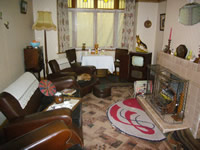 lady living there and it has been her and her families home since the 50’s. But an old lady isn’t going to have a TV and computer in every room or a dishwasher and tumble dryer in the kitchen either and so the existing system has never needed upgrading and in a lot of cases kept going quite nicely thank you.
lady living there and it has been her and her families home since the 50’s. But an old lady isn’t going to have a TV and computer in every room or a dishwasher and tumble dryer in the kitchen either and so the existing system has never needed upgrading and in a lot of cases kept going quite nicely thank you.
But the modern family’s needs are very different and this is where the second scenario comes in. With extension after extension, sockets getting added one by one through the years and then new families moving into the property only to have the electrics creaking under the extended strain we get called in to see why the fuses keep tripping only to find that the core wiring of the home just can’t take the strain anymore.
It is then that we find these old wiring systems that in some cases need to be replaced in order to match in and bring it up to spec with the newer wiring in the property etc.
Paper
- Paper insulation
- From the WW1 era
- Very rare now in domestic wiring
- Paper is somewhat hygroscopic
- Pre-war paper cable is still in service in distribution networks, and causes a good deal of downtime
- The polychlorinated biphenyl (PCB) oil used in old paper insulation is toxic, and the insulation should not be handled with bare hands
Lead sheathed
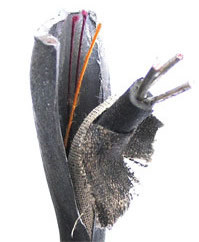
- Common in 1930s for socket circuits
- Used as exterior farm cable well after that
- Lead sheath does not make reliable earth connections
- Rubber inner insulation
- Tail rubber insulation tends to disintegrate, and muck accumulates on cable ends causing leakage
VIR
- Vulcanised India Rubber insulated cable.
- Along with imperial T&E, one of the most common historic wiring cables still in use
- Comes in 2 forms:
- Twisted pair, cotton/rubber insulated, with no outer sheath
- singles drawn into conduit
- Most VIR wiring doesn’t
 include an earth wire, which is sometimes run as a separate uninsulated single.
include an earth wire, which is sometimes run as a separate uninsulated single. - Rated to 60C
- Rubber insulation perishes, cracks & falls off
- Properties with VIR cable are usually inurgent need of rewiring, and may represent a significant safety risk. However some of the Jute / Hessian reinforced rubber cables that are often seen on consumer unit incomers are still often relatively safe.
A good percentage of the remaining old VIR wiring is now in a dangerous condition, especially at termination points. It is common to see insulation that has fallen off, often leaving live & neutral conductors bare, unsupported and in very close proximity. In the worst cases 2 bare conductors can be found twisted round each other with nothing rigid to support them.
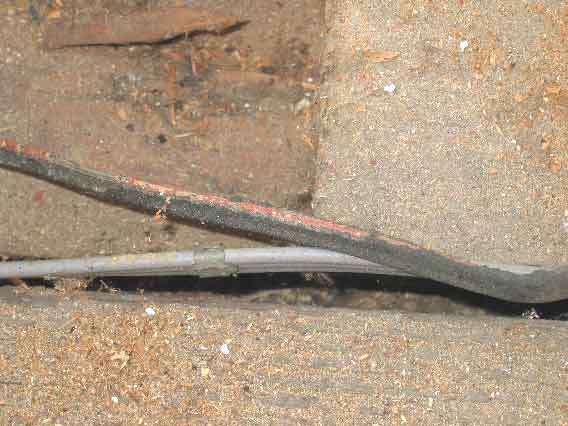
The outer insulation has failed on the black sheath of the cable, and in one place the insulation on the inner live wire has also cracked off. This cable is in a very poor state, and is unsafe.
The rule of thumb with old rubber wiring is
- replace it as soon as possible
- don’t move it at all, even small movement sometimes causes shorts.
This situation is quite different to early American rubber wiring, which is usually still in sound condition, due to the use of a different rubber formulation.
TRS

- Tough Rubber Sheath
- Rubber insulated conductors with a rubber outer sheath
- still used today but more often found used by bands, on stage, on the road and in the theatre.
CTS
- Cab Tyre Sheathed
- Tinned copper conductors, each core insulated with VIR, & cab tyre outer sheath
- Single, Flat Twin and Flat Triple
- Cab tyre was the same rubber formula used for car tyres, making this cable a very tough rubber cable
Aluminium
- Cheaper alternative to copper
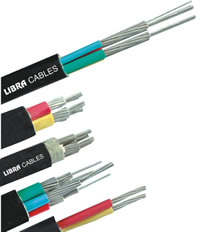
- Used from 1950s to 1970s, and old stock sometimes used into the 1980s.
- The insulation & sheathing is mostly the same as T&E – PVC for decades, may be rubber on older cable.
- A known fire risk
- Aluminium cable creeps, oxidises & fractures, all of which can cause fires.
- Requires special connections, do not connect to old aluminium cable using connectors intended for copper.
- Al requires a larger conductor size than Cu for the same current rating
- Presence of aluminium cable may be considered a material fact for insurance.
- The main problem with aluminium cable is its thermal expansion coefficient. Repeated temperature cycling causes it to come loose at connection points, and it then oxidises, and aluminium oxide is an insulator. Bad connections generate excessive heat and fire can break out.Having said all that aliminium cable still has its uses and so is still being manufactured today. Aluminum provides a much better conductivity to weight ratio than copper, and therefore is used in power wiring of some aircraft. With the prices of copper going through the roof people are looking at aluminium again and trying to work out better ways of using it such as for car speaker systems.
Copper Clad Aluminium
- Each conductor has an aluminium core
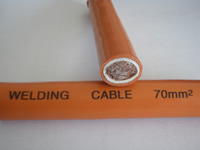 surrounded by copper
surrounded by copper - An attempt to improve the properties of aluminium cable
- Significantly better than al, the surface oxidation problem is eliminated, creep reduced & the risk from cracking more or less eliminated.
- Primarily still being produced and used as welding cable
PBJ
- PolyButyl Jute insulated cable
- Rubberised Hessian appearance to the sheath.
- The surface is these cables is quite uneven
- Commonly used for mains incomer insulation
- Lots of old PBJ is still safely in service
Imperial T&EÂ (Twin and Earth)
PVC twin

Older T&E wiring having similar construction to today’s cables. Several versions exist:
- 7/.029 T&E
- imperial 7 stranded version of 2.5mm² T&E
- used for socket circuits until unstranded 2.5mm T&E was introduced around 1970
- strands are 0.029″ diameter = 0.74mm
- 3/.029 T&E
- imperial 3 stranded version of 1mm² T&E
- used for lighting circuits
- 1/.044″ unstranded lighting cable also used
- Ashathene T&E
- Precursor to PVC T&E
- Lasts well
- PVC outer VIR inner
- an early T&E cable
- where the inner rubber has failed, the tails can be sleeved
- 2 core Twin
- no earth, used for lighting circuits, or power circuits with a separate (usually uninsulated) single run alongside to provide an earth.
PVC and ashathene versions of this cable last well and are usually in good condition, but rubber does not last well long term.
PVC outer rubber inner cable can have its rubber ends sleeved to make it safe, as its only the ends where exposed to air where the rubber becomes brittle and falls off. Cable with rubber outer insulation can not be made safe this way.
Iron wire
From the late 1800s to the 1920s, self contained 32v lighting systems (run by a small generator) were installed using bare iron wire. The wire was in the region of 1/4″-1/2″ diameter, with no insulation at all. Very unlikely to be encountered today.
In Conclusion
While we were doing the research to proofe this article we found a few manufacturers, admittedly in India and china, still selling brand new Vulcanised Rubber, and Aluminium cable for use in the home.
As well as Copper Clad Aluminium cables starting to be used again (in a fight against the high price of copper) as speaker wire in cars, of all places, in the United States.
